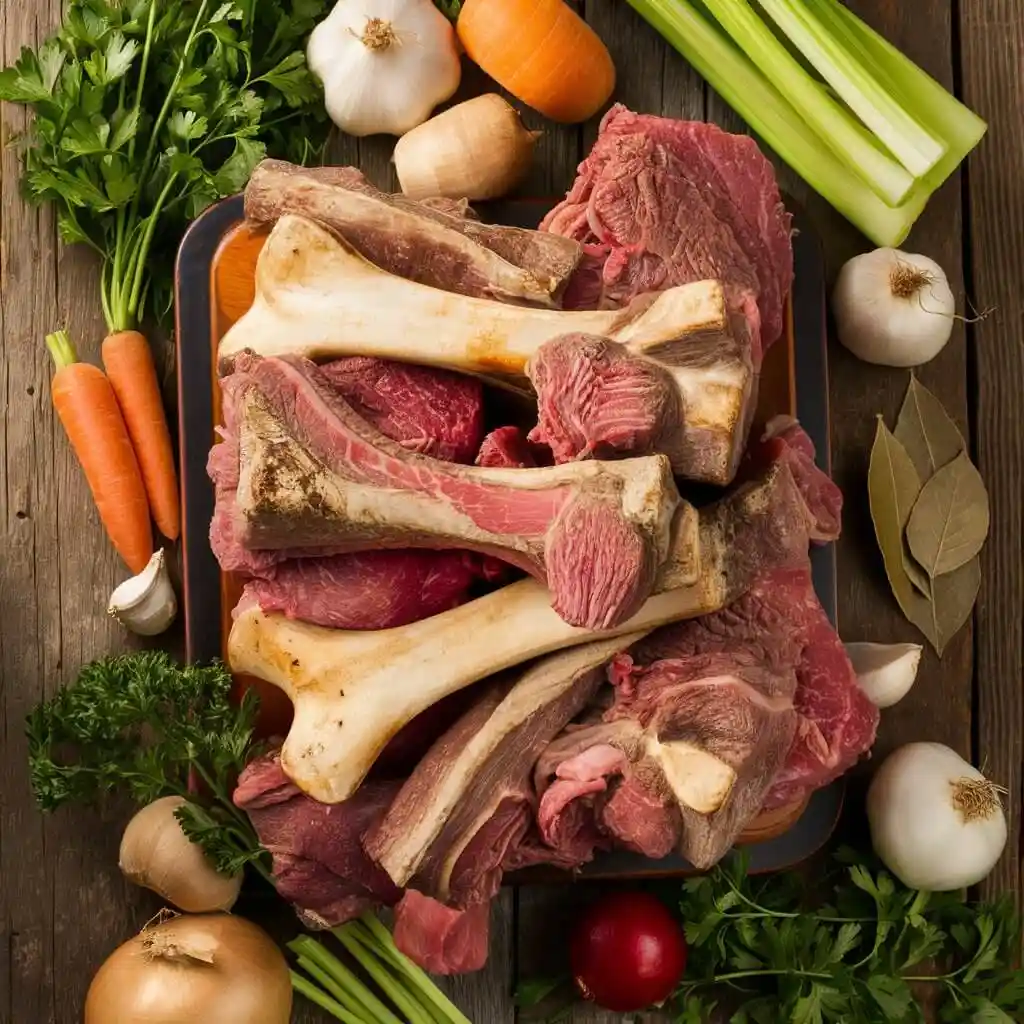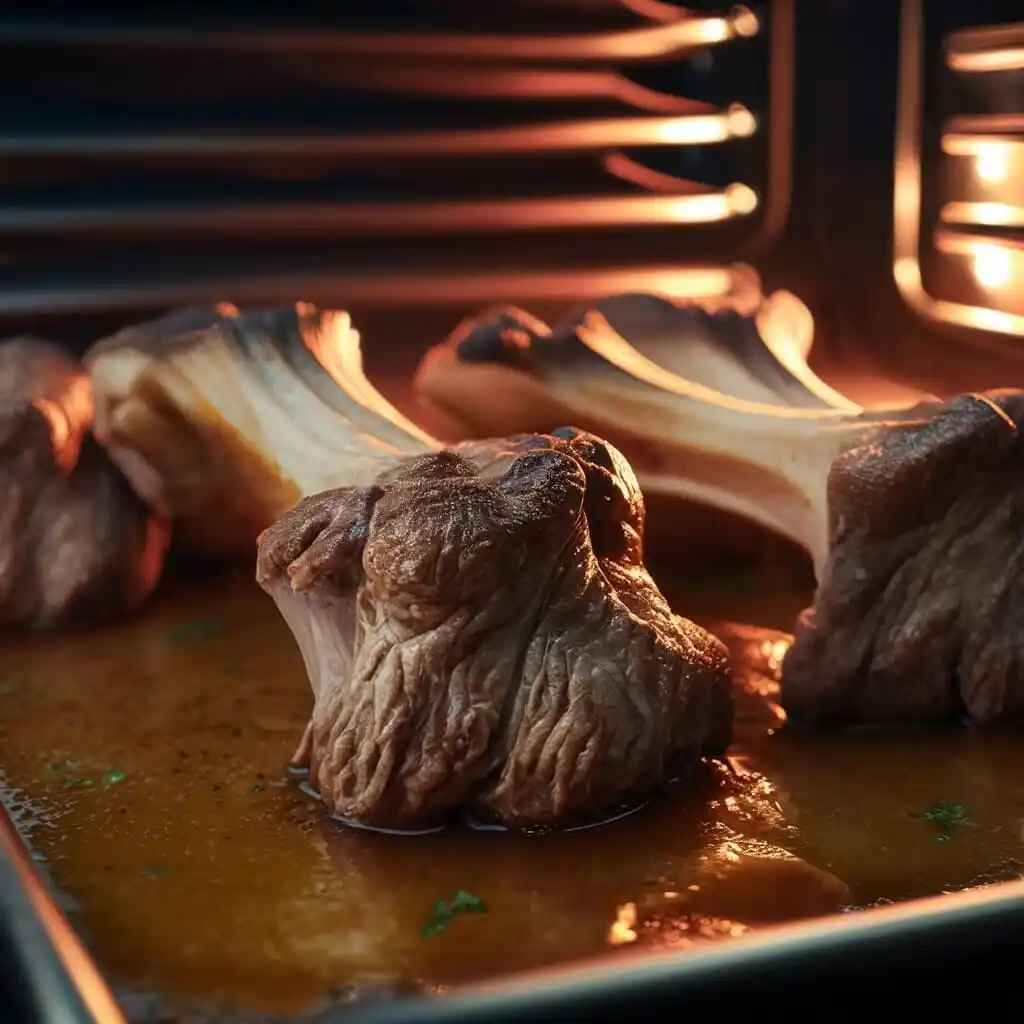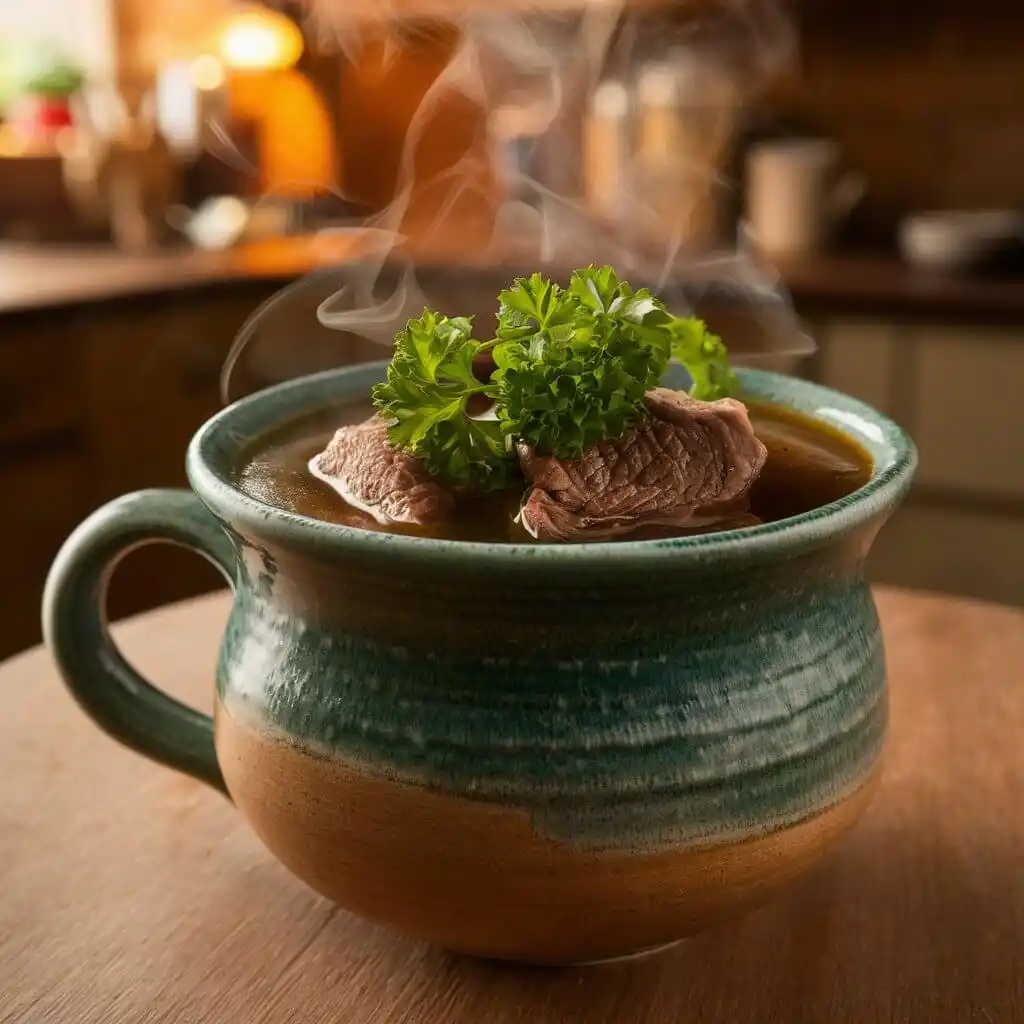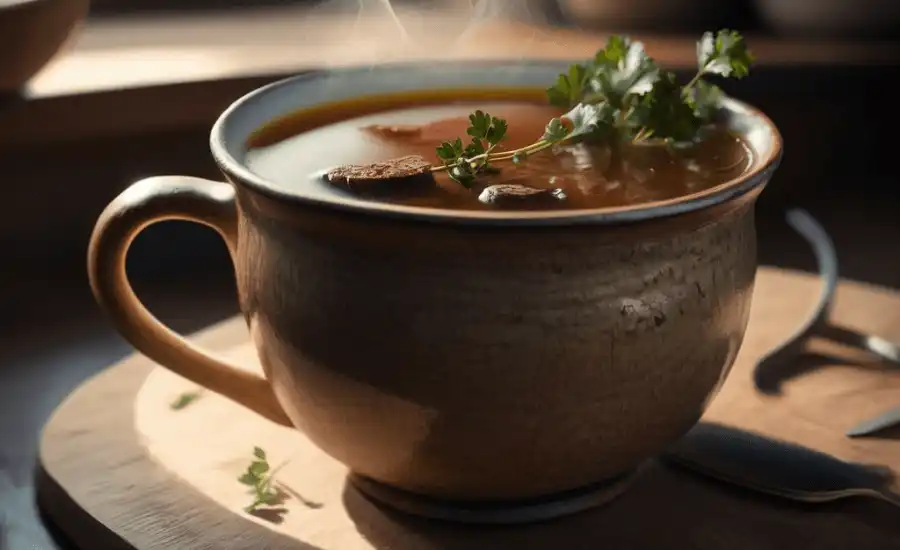Nothing beats the cozy comfort of a warm mug of homemade beef broth on a chilly day, it’s like a hug from grandma’s kitchen! This soup bones recipe transforms humble beef soup bones with meat into a rich, nutrient-packed broth that’s perfect for sipping, cooking, or elevating your favorite soups. Whether you’re a beginner looking to master the best beef bone soup recipe or a seasoned cook wanting a versatile base, this guide makes it easy and rewarding. Using soup bones for bone broth is not only budget-friendly but also delivers a collagen-rich, savory stock that’s a staple in any kitchen. With just a few ingredients and a little time, you’ll create a broth that’s bursting with flavor and nourishment. Ready to dive into this soul-warming recipe? Let’s get started with the ultimate guide to crafting a broth that’ll make your heart sing!
Table of Contents
Why You’ll Love This Recipe
This soup bones recipe is a game-changer for any home cook, and here’s why you’ll fall in love with it! First, it’s incredibly budget-friendly, beef soup bones with meat are affordable and widely available at local butchers or grocery stores, making this a wallet-friendly way to create a homemade beef broth. Second, it’s packed with health benefits; simmering soup bones for bone broth extracts collagen and minerals that support joint health, digestion, and overall wellness. Plus, this recipe is versatile, you can sip the broth as a comforting drink, use it as a base for hearty soups, or add it to risottos and sauces for extra depth. Best of all, it’s easy! Whether you use a stockpot or slow cooker, this best beef bone soup recipe is mostly hands-off, letting you create a nutrient-rich masterpiece with minimal effort. Get ready to transform simple ingredients into a soul-warming kitchen staple!
Ingredients
To create a rich, flavorful soup bones broth, you’ll need just a handful of simple ingredients that work together to build deep, savory notes. Here’s everything you need for the best beef bone soup recipe, along with why each ingredient matters and substitution options to suit your needs.
- 4 lbs beef soup bones with meat (shank, knuckle, or marrow bones): These are the heart of the recipe, providing rich flavor and collagen. Look for bones with some meat attached for extra depth. Source them from a local butcher for the best quality.
- 1 large onion, quartered: Adds sweetness and a savory backbone to the broth. No need to peel, skins enhance color.
- 2 carrots, roughly chopped: Contributes subtle sweetness and balances flavors.
- 2 celery stalks, roughly chopped: Brings a fresh, herbaceous note to the homemade beef broth.
- 4 garlic cloves, smashed: Infuses a warm, aromatic depth.
- 2 bay leaves: Adds a subtle, earthy flavor that complements the bones.
- 1 tbsp apple cider vinegar: Helps extract nutrients and collagen from the soup bones for bone broth, making it nutrient-dense.
- 1 tsp black peppercorns: Provides a mild, peppery kick without overpowering.
- 1 tsp kosher salt: Enhances all flavors (adjust to taste).
- 1 small bunch fresh parsley (or 1 tbsp dried): Adds a fresh, herbaceous finish.
- Use about 10 cups of water as the base, making sure the bones are completely covered.
- Optional but flavorful: Add 1 tablespoon of tomato paste to intensify the umami depth.
Substitutions:
- Low-Sodium: Skip the salt or use a low-sodium alternative.
- Vegan/Vegetarian: This recipe relies on beef soup bones with meat, but you can explore plant-based broth alternatives with mushrooms or vegetables for similar depth.
- Gluten-Free: Naturally gluten-free; just check tomato paste for cross-contamination.
Why It Works: Roasting the bones and simmering with aromatics like onion and garlic creates a collagen-rich broth that’s both flavorful and nourishing. The apple cider vinegar is key to unlocking the bones’ nutrients, making this broth a health powerhouse.

Step-by-Step Instructions
Creating a rich, flavorful soup bones broth is easier than you think! Follow these five simple steps to transform beef soup bones with meat into the best beef bone soup recipe that’s perfect for sipping or cooking. With expert tips and troubleshooting advice, you’ll nail this homemade beef broth every time.
Preheat Oven to 400°F (204°C)
Roasting the soup bones for bone broth unlocks deep, savory flavors. Place the 4 lbs of beef soup bones on a baking sheet, ensuring they’re spread out evenly. Roast for 30–40 minutes, flipping halfway, until they’re golden brown and aromatic. This step caramelizes the meat and bones, giving your broth a rich, hearty taste.

Prepare the Stockpot
Transfer the roasted bones to a large stockpot or slow cooker.Add the onion (quartered), diced carrots and celery, crushed garlic cloves, bay leaves, whole peppercorns, a pinch of kosher salt, and a few sprigs of fresh parsley to the pot. And mix in a tablespoon of apple cider vinegar and enough water, roughly 10 cups, to ensure the bones are submerged by two inches. The acidity of the vinegar helps release collagen and essential nutrients from the bones.
Simmer the Broth
Heat over medium-high until small bubbles start to rise softly to the surface. Once boiling, reduce to a low simmer and skim off any foam or impurities that rise to the surface. Place the lid on and simmer slowly for 12 to 24 hours, extended cooking will deepen the flavor. If using a slow cooker, set it to low for the same duration. Check so often and top off with water if the liquid drops below the bones.
Strain the Broth
Carefully remove the bones and vegetables using tongs. Strain the broth through a fine mesh strainer or cheesecloth into a large bowl to remove any solids. You’ll be left with a golden, fragrant homemade beef broth that’s ready to use or store.
Cool and Store
Allow the broth to cool a bit, then transfer it into airtight containers using a ladle. Keep in the refrigerator for no more than 5 days, or freeze for long-term storage, up to 6 months. For a lighter broth, skim off any solidified fat after chilling.
Expert Tips:
- Maximize Flavor: Roasting is optional but highly recommended for a deeper, more robust broth.
- Slow Cooker Ease: Use a slow cooker for a hands-off approach, perfect for busy days!
- Clear Broth: Skim foam regularly during the first hour to avoid cloudiness.
- Boost Nutrients: Simmer for 24 hours to extract maximum collagen and minerals.
Troubleshooting:
- Cloudy Broth? Boil gently, not vigorously, and skim foam diligently.
- Weak Flavor? Roast bones longer or add a tablespoon of tomato paste for umami.
- Too Greasy? Chill the broth and skim off the fat layer before using.
Tips and Variations
Making the best beef bone soup recipe is all about flexibility and flavor! These tips and variations will help you customize your soup bones broth to suit your taste, dietary needs, or kitchen schedule. Whether you’re aiming for a richer homemade beef broth or adapting for specific diets, these ideas will elevate your soup bones for bone broth experience.
- Choose Quality Bones: Opt for beef soup bones with meat from a local butcher or farmers’ market for the freshest, most flavorful results. Grass-fed bones often yield a richer taste and more nutrients.
- Boost Flavor: Add aromatics like a 1-inch piece of fresh ginger, a sprig of thyme, or rosemary for a unique twist. For an umami kick, stir in 1 tbsp of tomato paste during simmering.
- Time-Saving Hack: Short on time? Use an Instant Pot to make broth in 3–4 hours on high pressure instead of 12–24 hours. Follow the same steps, then let the pressure release naturally.
- Clearer Broth: For a crystal-clear homemade beef broth, strain twice through cheesecloth and avoid stirring the pot too much during simmering.
- Kid-Friendly: Blend or strain the broth thoroughly for a smoother texture that kids will love when used in soups or sipped as a warm drink.
- Budget Tip: Soup bones are often inexpensive, check your grocery store’s meat section or ask for scraps to keep costs low.
Dietary Variations:
- Low-Sodium: Omit the kosher salt or use a low-sodium alternative to control salt levels. Taste and adjust before serving.
- Gluten-Free: This recipe is naturally gluten-free. Just double-check optional ingredients like tomato paste for any hidden gluten.
- Vegan/Vegetarian: Since this recipe relies on beef soup bones with meat, try a plant-based broth with mushrooms or vegetables for similar depth.
- Spicy Twist: Add a dried chili pepper or a pinch of red pepper flakes during simmering for a subtle heat.
Storage Tip: Freeze broth in ice cube trays for small portions perfect for sauces or single servings, making this soup bones recipe even more versatile.
Storage
Proper storage ensures your soup bones broth stays fresh and ready to elevate your dishes! This homemade beef broth is a versatile staple, and with these simple guidelines, you can keep it tasting great whether you’re using it tomorrow or months from now. Here’s how to store your best beef bone soup recipe for maximum freshness.
- Refrigeration: After cooling, pour the broth into airtight containers or glass jars. You can refrigerate it for up to five days without losing freshness. A layer of fat may form on top, this is normal and acts as a natural seal to keep the broth fresh. Skim it off before using if you prefer a lighter flavor.
- Freezing: For long-term storage, use airtight containers or freezer bags to keep the broth for up to 6 months. To make portioning easier, freeze the broth in ice cube trays, perfect for adding to sauces or using in single servings.
- Reheating: Gently reheat on the stovetop over low heat to preserve nutrients and flavor. Avoid boiling to maintain the broth’s clarity and texture.
- Pro Tip: Label containers with the date to track freshness. When freezing, be sure to leave some space at the top of containers to allow for the liquid to expand as it freezes.
Troubleshooting: If the broth smells off or develops a slimy texture, discard it immediately. Always store in clean, sanitized containers to prevent spoilage.
How to Serve
Your soup bones broth is ready to shine, and serving it creatively can make every sip or dish feel special! This homemade beef broth is incredibly versatile, perfect for sipping on its own or elevating a variety of recipes. Here are some delightful ways to enjoy the best beef bone soup recipe, along with tips to present it beautifully for a cozy, inviting experience.
- Sip as a Warm Drink: Season the soup bones for bone broth with a pinch of salt and a sprinkle of fresh parsley for a nourishing, collagen-rich drink. Serve in a rustic ceramic mug for a comforting, café-like vibe, perfect for chilly mornings or a mid-afternoon pick-me-up.
- Soup Base: Use this broth as the foundation for hearty dishes like vegetable soup or French onion soup. Its rich, savory flavor adds depth to any recipe.
- Cooking Versatility: Incorporate into risottos, gravies, or casseroles for a boost of umami. A splash of this beef soup bones with meat broth can transform simple dishes into gourmet creations.
- Presentation Ideas: Garnish the broth with fresh herbs like chives or thyme, and serve it in clear glass bowls to highlight its golden color. Pair it with warm, crusty bread or a light salad for a comforting meal.
Pro Tip: Warm your mugs or bowls before serving to keep the broth piping hot.

Nutritional Breakdown
This soup bones broth isn’t just delicious, it’s a nutritional powerhouse! Made from beef soup bones with meat, this homemade beef broth is packed with health benefits, making it a fantastic addition to your diet. Below is the approximate nutritional profile for a 1-cup (240 ml) serving of this best beef bone soup recipe, along with insights into why it’s so good for you.
- Calories: ~20 kcal (low-calorie, perfect for light meals or sipping)
- Protein: ~2g (supports muscle repair and satiety)
- Fat: ~0.5g (minimal, especially if fat is skimmed after chilling)
- Carbohydrates: 0g (ideal for low-carb or keto diets)
- Collagen: High (varies by simmer time, promotes joint health and skin elasticity)
- Minerals: Rich in calcium, magnesium, and phosphorus (extracted from soup bones for bone broth, supports bone health)
Health Benefits:
- Collagen-Rich: Long simmering extracts collagen, which may improve joint health, skin elasticity, and digestion.
- Nutrient-Dense: The beef soup bones with meat release minerals and amino acids, supporting overall wellness.
- Low-Calorie: A guilt-free option for sipping or adding to recipes without adding heavy calories.
Note: Nutritional content varies based on bone type, simmer duration, and whether fat is skimmed. For precise values, consider testing with a nutritional analysis tool. This broth is naturally gluten-free and low-carb, making it versatile for various dietary needs.
FAQs
Got questions about making the best beef bone soup recipe? We’ve got answers! Below are the most common questions about using soup bones to create a rich, flavorful homemade beef broth, pulled from real-time insights like Google’s “People Also Ask” and tailored to this recipe. These answers address everything from cooking tips to health benefits, ensuring you’re ready to master soup bones for bone broth.
1. What are soup bones for?
Soup bones, typically beef bones with some meat attached, are used to make nutrient-rich broths and stocks. By simmering beef soup bones with meat, you extract collagen, gelatin, and minerals, creating a flavorful base for soups, stews, sauces, or sipping as a health-boosting drink.
2. How do soup bones differ from marrow bones?
Soup bones contain meat and connective tissue, making them perfect for rich, flavorful broths. Marrow bones, often femur or shank bones, are richer in marrow and used for both broth and extracting marrow for spreads. Soup bones are generally meatier and more budget-friendly.
3. What is another name for soup bones?
Soup bones are also called stock bones, broth bones, knuckle bones, or shank bones, depending on the cut or region. These terms all refer to bones used to create a savory, collagen-rich broth.
4. What is a soup bone slang?
In culinary terms, soup bones are specifically used to prepare broth. In slang, particularly in baseball, “soup bone” refers to a pitcher’s throwing arm, highlighting its strength or wear. For this recipe, we’re sticking to the kitchen definition!
5. Can I make bone broth in an Instant Pot?
Yes! To save time, use an Instant Pot instead of simmering for 12–24 hours. Follow the same process with the same ingredients and cook under high pressure for 3 to 4 hours, allowing the pressure to release on its own for optimal results.
6. How do I make bone broth clearer?
For a clearer homemade beef broth, simmer gently (avoid a rolling boil), skim foam regularly during the first hour, and strain twice through a fine mesh strainer or cheesecloth. Roasting bones lightly also helps reduce cloudiness.
7. Is bone broth good for you?
Absolutely! Broth from soup bones is rich in collagen, which supports joint health, skin elasticity, and digestion. It also contains minerals like calcium and magnesium, making it a nutrient-dense option for overall wellness.
8. Can I freeze bone broth?
Yes, freeze your soup bones for bone broth in airtight containers or freezer bags for up to 6 months. For convenience, pour into ice cube trays for small portions, perfect for adding to sauces or single servings.
9. What if my broth is too watery?
If your broth lacks depth, simmer it longer (up to 24 hours) to concentrate flavors. You can also reduce it uncovered to thicken, or add a tablespoon of tomato paste for extra umami. Ensure you’re using enough beef soup bones with meat for richness.
10. Are soup bones gluten-free?
Yes, this best beef bone broth contains no gluten, it’s naturally suitable for gluten-free diets. Just double-check optional ingredients like tomato paste to ensure no cross-contamination with gluten-containing additives.
Conclusion
There’s something truly magical about turning simple soup bones into a rich, nourishing homemade beef broth that warms both body and soul. This best beef bone soup recipe is your ticket to creating a versatile, budget-friendly, and nutrient-packed kitchen staple that elevates everything from cozy soups to savory sauces. Whether you’re sipping it on a chilly evening or using it as the base for a hearty meal, this soup bones for bone broth recipe is sure to become a favorite. With minimal effort and maximum flavor, you’ll feel like a culinary rockstar! So, grab those beef soup bones with meat, fire up your stockpot or slow cooker, and let the aroma fill your kitchen. Ready to get cooking? Try making it yourself and let others know how yours turned out! Happy simmering!

